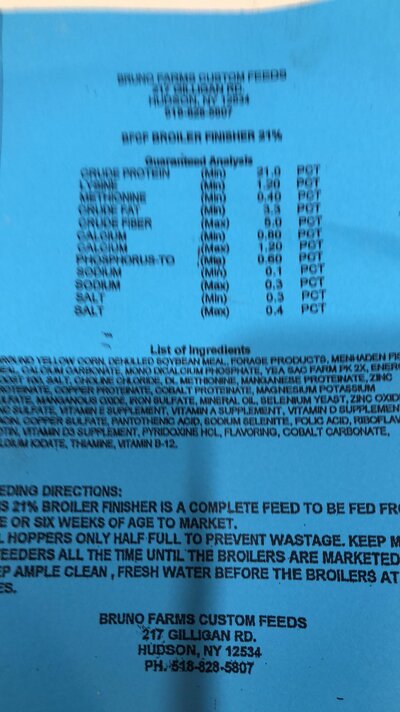U_Stormcrow
Crossing the Road
Math doesn't lie.Well, for your information, I'd hardly say that Amy Fewell is only concerned with making a pretty website. She just so happens to be the founder of the Homesteaders of America, alongside publishing 3 books, one being titled The Homesteader's Natural Chicken Keeping Handbook. She is an herbalist and has published a book alongside Joel Salatin titled The Homesteader's Herbal Companion. She and her husband also own their own farm. I think she may know a think or two about chickens and running a farm. I'd encourage you to check her out, especially before making your own ignorant comments.
That's not a recipe. Its note even a collection of recipes. Its merely a list of ingredients to be thrown together in innumerable combinations, with innumerable (and widly variable) outputs, few if any of which would hit minimum recommends for modern feed formulations.
and if you don't understand the problem in simultaneously saying "free choice" and "not to exceed 5%" about the same ingredient, I submit that you should probably hit the books some more.
She may well be an authority on other things, but she's clearly not to be relied on for making chicken feed at home - Joel has a useful, working, RECIPE. If the writer of that website understood why Joel's recipe worked, how the ingredients worked together, and why the ratios he uses are the ratios he uses, they wouldn't have written that website as they did. Joel also has a system, and if you use his recipe without his system, you invite other problems.
here, I'll help - Salatin's broiler recipe:
52% corn — For carbohydrates
29% roasted soybeans — For protein
11% crimped oats — These are a source of protein and carbs, but Salatin primarily includes oats because of the fiber in the hulls.
3.5% Sea-Lac brand fish meal — He prefers this brand because of their low-heat processing, which helps preserve vitamins and minerals. The other purpose of fish meal is to provide animal protein.
3% Fertrell Nutri-Balancer — For vitamins and minerals. (See below.)
1% feed grade limestone — For calcium
0.5% kelp meal — For minerals. Salatin recommends choosing kelp meal grown in cold water and dried geothermally.
0.1% Fastrack probiotic — To promote digestion and boost the immune system. This brand name product is produced by Conklin Co., Inc., and Salatin says they have the highest percentage of Lactobaccillus acidophilus, without the fillers found in other brands of probiotics
Every one of us could follow that, and get the same output (w/i reasonable variation for local differences in corn, roasted soybean, and crimped oats, of course)
and here's his layer ration:
49.7% corn
30.8% roasted soybeans
10.9% oats
5.0% feed grade limestone
3.0% Fertrell Nutri-Balancer
0.5% Thorvin brand kelp meal
Again, we can all follow that and end up with similar outputs.
and FWIW, I wrote a book too. and live on a hobby farm. and know a thing or three about chicken nutrition. Not really the sociable type, no interest in forming or running a group for anyone. But don't take my word for it, do the math for yourself.
{For purposes of Clarity, I cut and pasted Salatin's recipes from here - complete with their comments, not always the comments I would make. I've found Salatin's recipes posted elsewhere, substantially identical to this, but this is the one I have bookmarked, so its the one I used. Salatin doesn't make his own stuff free to link - got to sell more books, after all - and that's fine by me, it his labor, he can value it any way he wants.}
Last edited:





